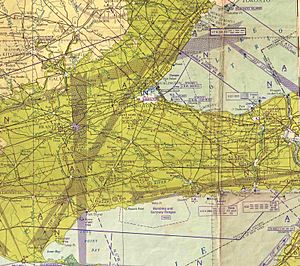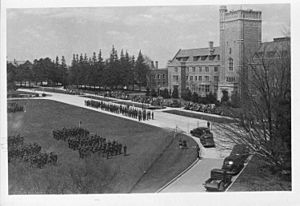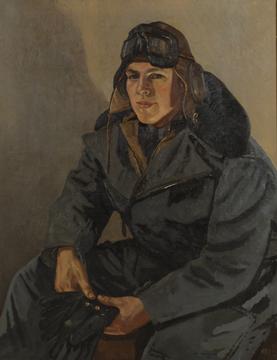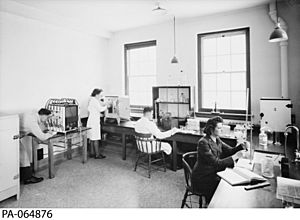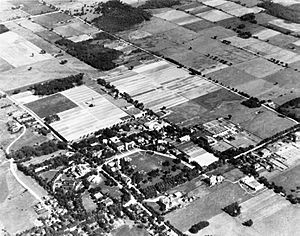RCAF Station Guelph facts for kids
Quick facts for kids RCAF Station Guelph |
|
|---|---|

Johnston Hall, University of Guelph. In 1941 this building was station HQ.
|
|
| Active | 7 July 1941 – 12 January 1945 |
| Country | Canada |
| Branch | Royal Canadian Air Force |
| Role | British Commonwealth Air Training Plan Aircrew and groundcrew training |
| Part of | No. 1 Training Command |
| Testing | No. 1 Nutritional Laboratory No. 1 Test Kitchen Unit |
| Schools | No. 4 Wireless School RCAF School of Cookery No. 15 RCAF Detachment [Radio Mechanics School] No. 1 Code and Cypher School No. 15 Pre-Aircrew Education Detachment |
| Station Magazine | Sparks |
| Commanders | |
| G/C | A. H. Keith Russell - June 1941 |
| G/C | D. G. Williams - May 1943 |
| W/C | J. H. Roberts - May 1944 |
| W/C | D. J. R. Cairns - October 1944 |
| Aircraft flown | |
| Trainer | De Havilland Menasco Moth Noorduyn Norseman North American Yale North American Harvard |
RCAF Station Guelph was an important training base during the Second World War. It was part of the British Commonwealth Air Training Plan (BCATP). This plan helped train pilots, aircrew, and ground crew from many countries during the war. The station was located in Guelph, Ontario, on the campus of the Ontario Agricultural College (OAC) and other schools.
The base was often called No. 4 Wireless School. It was home to several training programs and even test kitchens for the air force.
The connection between the Royal Canadian Air Force (RCAF) and the OAC started in January 1940. The air force began sending airmen to the OAC to learn how to be chefs. In May 1941, the RCAF took over a large part of the campus. By July 1941, a full RCAF air station was running, with its main office in Johnston Hall.
The biggest school at the base was the Wireless School. It trained airmen to become Wireless Operators. These operators learned to send and receive messages using radio. Many then went on to Bombing and Gunnery School to become Wireless Air Gunners. These airmen worked as part of the crew on large aircraft. They served in different air force groups, helping with bombing, coastal patrols, and ferrying planes. Some airwomen were also trained as Wireless Operator, Ground, meaning they worked with radios on the ground.
The second largest school was the School of Cookery. This school trained both airmen and airwomen to be chefs for air force bases.
The British Commonwealth Air Training Plan was a temporary program for wartime. It was planned to end in March 1945. No. 4 Wireless School officially closed on January 12, 1945. The RCAF then returned the campus to the OAC in February 1945.
More than 8,000 airmen and airwomen were trained at RCAF Station Guelph during the war.
Contents
A Challenging Start
Setting up the RCAF station in Guelph caused a big discussion. Newspapers in Toronto and Guelph, and farm groups, reported on it widely. On February 28, 1941, the Premier of Ontario, Mr. Mitchell Hepburn, announced that the OAC would be given to the federal government for the war effort.
Many people, including the City of Guelph and farm groups, did not like this idea. They did not want the Ontario Agriculture College to close. Mr. George Alexander Drew, who was the leader of the opposition in the government, supported their cause.
After much debate, the government voted for a compromise on March 7, 1941. The OAC would stay open for classes, and the RCAF could use the campus for No. 4 Wireless School. The RCAF would get the dorms and instructors they needed. OAC students would have to live off-campus. Classes at the Macdonald Institute were completely stopped. It was up to the people of Guelph to make this plan work.
Construction started around May 10, 1941. By June 26, 1941, 100 Guelph men were working on the site. Buildings were changed inside, and new ones were built. These included a guardhouse and an armaments building (for shooting practice). A barbed wire fence was put up around the RCAF part of the campus. Eventually, the base had facilities for 1,500 RCAF staff. It also had its own police, fire services, and a hospital. This was similar in size to most air stations built in Canada during the war.
The first group of RCAF officers arrived on June 7, 1941. They were led by Wing Commander (W/C) A. H. K. Russell.
No. 4 Wireless School Opens
The first group of airmen started their wireless studies on July 7, 1941. There were 200 students, including three from Australia and one from the Royal Air Force.
W/C Russell explained what the school taught. He said students would learn math, radio theory, first aid, and signaling using code, lamps, and flags. They also spent time on physical training and games. Students also learned about aircraft radio equipment, how to fix radios, and even how to shoot clay targets. A very important skill was Morse Code. Airmen had to be able to send and receive messages at 18 words per minute.
Each day began with physical training. Students also had duties like cleaning dorms and moving coal for heating.
The official opening happened on Saturday, August 9, 1941. Air Commodore G. E. Brooks, a senior RCAF officer, inspected the school and the airmen. Other important people, both military and civilian, also attended.
Hundreds of people from the public visited the dorms, hospital, and kitchens. They watched demonstrations of wireless signaling, first aid, and cooking.
By the time of the official opening, there were 900 airmen at the station.
Wireless Aircrew Training Steps
The training for Wireless Operators and Wireless Air Gunners could take up to 45 weeks. In November 1942, the steps were:
- Manning Depot: 5 weeks (basic training)
- Tarmac Duty: 4–8 weeks (practical experience)
- Wireless School: 28 weeks (to become a Wireless Operator)
- Bombing and Gunnery School: 4 weeks (to become a Wireless Air Gunner)
Near the end of Wireless School, students moved from classrooms to practice signaling in aircraft. This part lasted several weeks. They practiced sending messages and finding directions using radio during local and cross-country flights. After about 30 hours of flying, their training was complete.
Even though people tried, no airfield was built right at No. 4 WS. For several years, students used the RCAF airfield at Burtch 43°03′08″N 080°16′29″W / 43.05222°N 80.27472°W for their flying practice. At first, they took buses daily from Guelph to Burtch. Later, a permanent camp was built there.
In 1944, the flying training moved to the RCAF airfield at St. Catharines, Ontario.
First Graduates
The first class of Wireless Operators finished their training at No. 4 Wireless School. They then went to No. 1 Bombing and Gunnery School. On December 20, 1941, they received their "wings" (a badge showing they were trained aircrew) in a ceremony. W/C Russell, the commanding officer of No. 4 WS, was invited to lead this ceremony.
Wireless Trainees and Their Service
Volunteer airmen and airwomen came to No. 4 WS from many places. These included Canada, Newfoundland, Britain, Australia, New Zealand, South Africa, and the United States. They trained to be Wireless Operators (WOPs). Most then went to Bombing & Gunnery School (B&GS) to become Wireless Air Gunners (WAGs). Some of the best students chose to become Navigators or instructors. A few became Wireless Operators, Ground (WOGs).
By the time the school closed, between 5,000 and 5,800 wireless operators had been trained there. Many of them later served in combat, and some lost their lives.
One of the most famous trainees from No. 4 was the Honourable Lincoln Alexander. He graduated as a Wireless Operator, Ground, and later became an instructor. On the 50th anniversary of No. 4 WS, he said, "I remember the friendship and the fun. It made me a man. It taught me what authority was all about. It taught me to respect others. I'm proud of my service."
Example: The Crew of Canso 9816 No. 162 Squadron RCAF used Canso aircraft for anti-submarine patrols. On June 13, 1944, Canso 9816 attacked and sank a German U-boat (submarine) called U-715. This happened about 200 miles north of the Shetland Islands. The Canso plane was damaged during the attack. The crew had to land it on the sea and leave the aircraft. They were rescued by another flying boat eight hours later. Sadly, three of the crew members died before help arrived.
The crew of Canso 9816 that day included:
- Wing Commander (W/C) Cecil G. W. "Bill" Chapman (pilot and squadron commander)
- Flying Officer (F/O) James M. McCrae (co-pilot)
- Flying Officer (F/O) Dave J. Waterbury (navigator)
- Warrant Officer 2 (WO2) Joseph J. C. Bergevin (wireless air gunner - wireless operator)
- Warrant Officer 2 (WO2) Frank K. Reed (wireless air gunner)
- Flight Sergeant (FSgt) Harry C. Leatherdale (flight engineer)
- Flight Sergeant (FSgt) Gerald F. Staples (wireless air gunner)
- Sergeant (Sgt) Robert F. Cromarty (flight engineer)
Reed, Leatherdale, and Staples died before rescue. Bergevin, Cromarty, and McCrae received awards for their bravery in this action.
RCAF School of Cookery
The RCAF started sending airmen to the OAC in January 1940 to train as chefs. The classes had 18 students and lasted 4 or 5 weeks. Professor Hugh D. Branion and Miss Jesse Lambden from the OAC were in charge. In October 1940, the class size grew to 36, and the course was made longer, to 6 weeks.
The main goal of the school was to teach people how to prepare healthy meals, use food wisely, and understand the RCAF diet.
When the air station was set up in July 1941, the chef courses became part of No. 4 Wireless School, known as the School of Cookery. The class size increased to 100 students. Professor Branion joined the RCAF and became Flight Lieutenant (F/L) Branion, the Officer in Command. Graduates were sent to other training centers and air stations across Canada.
Most of the instructors were civilians who used to work at the OAC and Macdonald Institute. Many of them were women.
The School of Cookery operated from January 2, 1940, until August 29, 1944. During that time, 2,000 chefs were trained. About half of the trainees were men and half were women.
No. 1 Nutritional Laboratory
The No. 1 Nutritional Laboratory was created in July 1941. F/L Hugh Branion was its commanding officer. This lab was part of the RCAF's medical branch. It tested food samples from all RCAF stations in Ontario and some in Quebec. This was to make sure that kitchens at these bases were preparing food correctly and safely. Staff from the lab would also visit the stations to inspect their kitchens.
No. 1 Test Kitchen
The No. 1 Test Kitchen was also set up in July 1941. New recipes were created and tested here before they were used at other air force bases. A typical recipe development took about 10 weeks. The Test Kitchen was located in Creelman Hall.
No. 15 RCAF Detachment - Radio Mechanics School
In the 1940s, "Radio Mechanic" was a secret term for "radar technician." Radar technology was very important and secret during the war. Thousands of technicians were needed to install and fix radar sets in planes and on the ground.
The RCAF started sending airmen to the OAC in June 1941 for training in electronics, radio, and radar theory. Classes had 75 students and lasted 13 weeks. Professor W. C. Blackwood of the Physics Department was in charge. Students who passed this course went on to practical training. This happened either at No. 31 Range and Direction Finding School in Canada or at similar places in the United Kingdom.
When the air station was established in July 1941, the Radio Mechanics School became part of No. 4 Wireless School. A total of 581 radio mechanics were trained before this school closed in March 1943.
Airwomen at the Station - The "WDs"
In November 1941, the first RCAF airwomen arrived at Guelph. They were training at the School of Cookery. After their training, they left for duty at RCAF Station Uplands on January 2, 1942.
Over time, more jobs were opened to airwomen. Some were trained in the Wireless section to become Wireless Operators, Ground. A/V/M William Bishop's daughter, AW2 Marise Bishop, graduated from No. 4 Wireless School in September 1944. She was part of the last group of airwomen wireless operators trained by the RCAF in World War II.
A small number of airwomen were also trained as Code and Cypher Clerks at No. 1 Code and Cypher School in Guelph.
Airwomen also worked as part of the station staff. They lived at the nearby Cutten Fields golf course.
Fun and Downtown Guelph
The station offered many chances for airmen to play sports. Teams were formed and joined leagues. Hockey was a popular sport. Once, some Australian airmen, who had never skated or played hockey, challenged a strong local team to a game! The No. 4 WS softball team won the area championship at least once. The soccer team played in the Guelph and District League against civilian teams. There was also a basketball team. Sports were also for entertainment. For example, a women's softball team from Toronto visited the station to play against the airmen's team.
The station had an entertainment center in the basement of War Memorial Hall. This center was run by the Royal Canadian Legion and the YWCA. Dances were held there, sometimes with famous bands like Mart Kenney and his Western Gentlemen. Airmen were also encouraged to put on their own variety shows.
Sometimes, the airmen could go downtown Guelph for fun. The King Edward Hotel, known as the "King Eddy," had a bar and a hall upstairs with a jukebox and dance floor. Ryan's department store also had dancing with live music on Wednesdays and Fridays.
Station Buildings and Sites
The RCAF used most of the buildings in the center of the campus. These included:
- Johnston Hall (headquarters, airmen's living quarters, and lounge)
- Mills Hall (airmen's lounge and quarters)
- Creelman Hall (airmen's dining hall, No. 1 Test Kitchen Unit)
- Maid's Hall (quarters for non-commissioned officers)
- Watson Hall (officers' quarters and dining hall)
- Macdonald Institute (classrooms)
- Macdonald Hall (airwomen's quarters)
- Macdonald Hall Annex (airwomen's laundry and lounge, female officers' quarters)
- Trent Institute (School of Cookery)
- Skating Rink (used as a drill hall)
- Farm Mechanics Building (offices, labs, and equipment)
- Gymnasium Building (gym)
- War Memorial Hall (auditorium and entertainment center)
- Bursar Hall (fire and police service)
- The Laundry (for washing clothes)
Today, some of these buildings have different names. The Farm Mechanics Building is now Blackwood Hall. Bursar Hall is called Drew Hall. The wartime gymnasium is gone, and the MacKinnon Building stands there now. The wartime skating rink is part of the Athletic Centre.
The Cutten Fields golf club is next to the OAC campus. The RCAF rented the clubhouse in 1941. The first floor was used to house airwomen, and the second floor housed female non-commissioned officers.
The RCAF also built a few "temporary" buildings. These included the guardhouse and armaments building on MacDonald St., a garage on College Ave., and barracks at the Cutten Fields. They also improved the water and sewage systems. The armaments building was used by the OAC and later by the University of Guelph. It was called the "Textiles and Design Building" until it was taken down around 2009. The barracks at Cutten Fields were called the "Annex" and were used by the club until they were taken down around 1970.
Today, in 2013, there are still several reminders of RCAF Station Guelph on the University of Guelph campus:
- A small plaque at the bottom of the Johnston Hall tower.
- A plaque in front of the H. L. Hutt building.
- Branion Plaza, named after Professor Hugh D. Branion, who led the RCAF School of Cookery.
- Blackwood Hall, named after Professor W. C. Blackwood, who was in charge of the Physics Department.
- Christie Lane, named after Dr. G. I. Christie, the President of the Ontario Agricultural College.
Honours and Awards
- Professor H. D. Branion received an award from the Dutch government in 1947.
- Father J. P. Lardie, the Roman Catholic Chaplain at 4 WS, was recognized for his service in 1945.
- Air Commodore A. H. K. Russell was made a Commander of the Order of the British Empire in 1946.
Remembrance
Eleven airmen sadly lost their lives while serving at No. 4 WS. Five of these deaths were in flying accidents.


